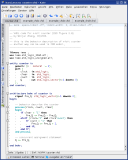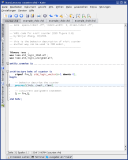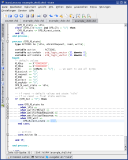VHDL EditorContentVHDL editors
In principle, a normal text editor would be sufficient to write VHDL code. But if you have to work with VHDL for a longer time, you will definitely profit from a good editor, since it can reduce your development time and spare your nerves. Here are some features that a really good editor should IMO have:
Of course, there are also open source alternatives, but AFAIK none of them support the syntax error highlighting. Anyway, Emacs / XEmacs seems to be one of the best editors for VHDL. Beside the platform independence Emacs can assert itself through a long list of features. In newer versions of Emacs (>= 20.4) the VHDL Mode is already part of the distribution. Just execute the following command in Emacs to load the module:
M-x vhdl-mode
At the time I had to decide which VHDL editor I was going to use, I decided to use kate. There are several reasons for this decision. First of all, the commercial tools SimplifIDE and Sigasi HDT did not yet exist, and Emacs was a bit complicated in use (very hard to setup your favorite shortcuts, or learn completely new ones) and for my project I did not need certain features. But compared to Xilinx' VHDL editor kate has already some very useful advantages, e.g. the code completion and the better performance. But to work with kate more efficiently some features had to be added, e.g. the functionality to collapse and expand blocks. This is not really a serious problem, because you just need to edit the syntax highlighting files of katepart and improve it as you wish. No sooner said than done. In the next section you can see the features of my adapted version of the vhdl.xml and download it if you like.
Improved syntax highlighting for VHDL in kate, kwrite, ... (KTextEditor)
Features:
~/.kde/share/apps/katepart/syntax/
Screenshots: 


Remark: I know this is still far from optimum, because the extremely important error highlighting is missing. But in some cases even this primitive syntax highlighting can be used to detect structural mistakes during editing:
Syntax highlighting for UCF files in kate, kwrite, ... (KTextEditor) |